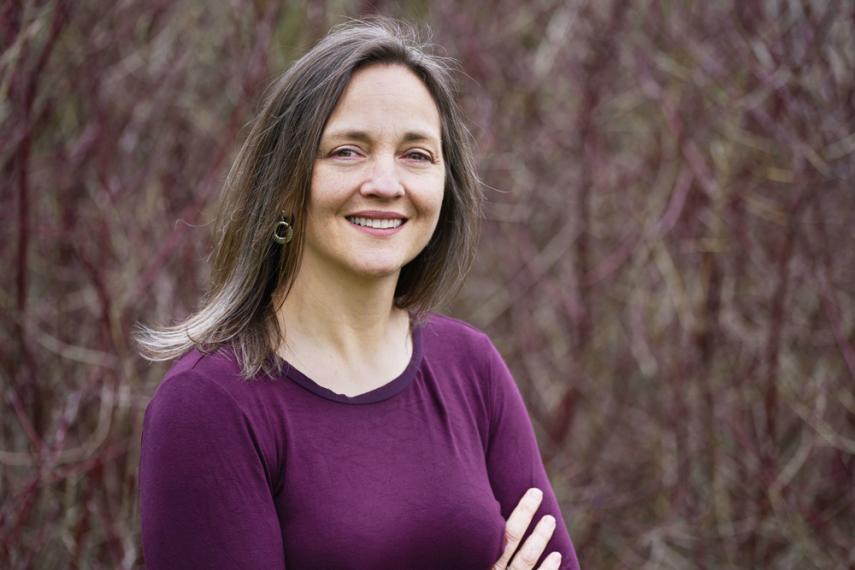Q&A with the Arboretum Director

Justine Richardson is the new director of the University of Guelph’s Arboretum. She started on February 3, 2020, and a lot has happened in the last year. She recently took some time to tell us all about the Arboretum’s activities during an unconventional, but very busy year.
You've had an interesting first year! What has helped you through the transition?
Interesting is right! I cannot say enough about the dedicated community of people engaged at the Arboretum. We have a truly wonderful team of knowledgeable staff who are passionate about this place. Their work supporting all aspects of the Arboretum, including transitioning a new director, has been amazing this year. I’m grateful we had a few “normal” weeks together before the pandemic shutdowns. I was also able to meet many of the volunteers, supporters, and regular Arboretum groups and visitors, who are enthusiastic about helping the Arboretum thrive.
What are you most proud of from the last year?
I am most proud of the way we served our community this past year. Staff members stepped up to adapt and meet the challenges. I am very proud of how together we continued to pursue our teaching, research, and outreach mandate.
- On top of the pandemic, we had drought last summer, and the horticulture team kept our living collections thriving in the greenhouse, nursery and collections, and kept gardens and trails beautiful and safe.
- Even with added procedures and without the help of our amazing volunteers, they also continued native species restoration, invasive species removals, and gene bank seed collection.
- Our nature interpreter team figured out how to shift education activities to online formats – after years dedicated to getting people off screens and into nature!
- We distributed hands-on activities and tri-lingual biodiversity identification sheets on Native Tree Leaves to thousands of grade 6 students in time for summer.
- Chris Earley’s popular bird ID noon-hour webinars reached hundreds participants coast to coast and internationally.
Tell us a bit about the 50th anniversary activities and plans.
In October, our 50th anniversary celebrations kicked off with an engaging talk “Local Leadership and Global Impact: Botanic Gardens Advancing Food Security” by Dr. Saharah Moon Chapotin, a plant scientist and Executive Director of the U.S. Botanic Garden. The virtual event featured a land acknowledgement voiced by all our staff, a report from the collections by Sean Fox, and a stunning musical performance by local percussionist Richard Burrows recorded in the summer.
We’re sharing lots of stories and images in our newsletter and social media (Instagram, Twitter, YouTube, Flickr and Facebook) to highlight research, people, and nature education in the “living laboratory” over the past five decades.
Next month we will launch a history website based on undergraduate student research. In May we will mark fifty years since planting our first formal collection – which was maples of course!
Watch the program videos and learn about upcoming activities here.
What are you most excited about for the future of the Arboretum?
The Arboretum has matured and is poised to play a role in so many issues of our day – from research about threatened and endangered species, to training the next generation of land-based practitioners, to advancing communication about the importance of biodiversity, to serving as a respite for exercise, human connection, and marking important life events. I believe the Arboretum’s relevance is growing.
I am excited about our plans for 2021. The list includes new virtual education programs, outreach to newcomers and international students, research and species recovery efforts for Elm and Red Mulberry, revitalization of our Gosling Wildlife Gardens, native planting restorations in the Wall-Custance Memorial Forest Boardwalk, plans for renovations in our Rosaceae collection, new partnership projects with indigenous researchers, and updating our strategic vision for years to come.
What’s a space in the Arboretum that you wish people knew about?
If you’ve ever come across tidy rows of trees growing in a part of the Arboretum, you’ve walked into one of our gene banks. These living collections archive rare, endangered, and threatened tree species, often grown from seed collected from surviving individual trees across the province. This work began in the 1970s under then Director R.J. Hilton and Curator John Ambrose.
I encourage people to slow down to listen and look closely to see what’s happening in an area they already know. I love doing this on the boardwalk through the old forest of Wild Goose Woods. Less well-known, North of College Avenue offers a broad vista of oaks and beeches, and a group of linden trees that dazzle yellow in the fall. This area is newly connected to the city trail systems via the Arboretum Side Trail. In early spring, the trilliums bloom in Victoria Woods. In summer, ecological restoration plantings near the Wall-Custance Memorial Grove light up with bright red native cardinal flower. And see if you can tell which area used to be a gravel pit!